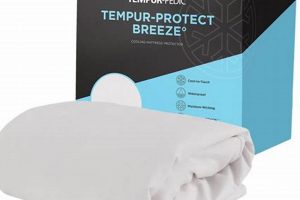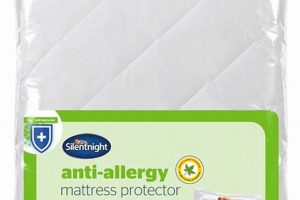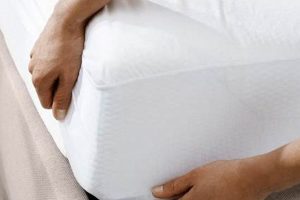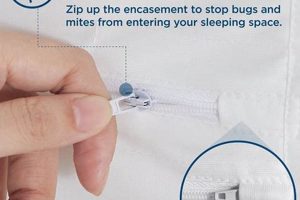These bedding accessories serve as a protective layer placed atop a mattress. They typically feature a fitted or anchored design to ensure secure placement and prevent shifting during use. An example of this type of product includes a quilted layer designed to increase comfort and simultaneously shield the underlying mattress from spills and stains.
Their use extends the lifespan of a mattress by safeguarding against everyday wear and tear, accidental liquid damage, and potential allergen accumulation. Historically, simpler versions were used to enhance mattress hygiene; modern iterations offer advanced features such as temperature regulation and enhanced cushioning, contributing to a more comfortable and hygienic sleep environment. This provides economic benefit through delayed mattress replacement.
The subsequent discussion will delve into the various types available, differentiating features, and key considerations for selection to meet individual needs and preferences. Factors such as material composition, thickness, and specific protective qualities will be explored in detail.
Guidance on Utilizing Mattress Protection
Optimal use of mattress protection products necessitates consideration of several key factors. This section provides actionable guidance for selecting and maintaining these items to maximize their protective capabilities and longevity.
Tip 1: Material Selection. Prioritize materials based on individual needs. Those prone to allergies should consider hypoallergenic options, while individuals seeking enhanced comfort may opt for materials like memory foam or natural fibers.
Tip 2: Waterproofing Assessment. Evaluate the level of waterproofing required. For households with children or pets, a fully waterproof option is advisable. For general protection, a water-resistant option may suffice.
Tip 3: Fit Verification. Ensure compatibility with the mattress size and depth. An improperly fitted protector may shift, reducing its protective effectiveness and causing discomfort.
Tip 4: Regular Cleaning Protocol. Adhere to the manufacturer’s cleaning instructions. Regular washing prevents allergen buildup and maintains the protector’s integrity.
Tip 5: Inspection for Wear. Periodically inspect the protector for signs of wear and tear, such as rips or thinning material. Prompt replacement is crucial to maintain its protective function.
Tip 6: Consider Breathability. Select options with breathable materials to prevent overheating and promote airflow, particularly important for warm sleepers.
Tip 7: Noise Reduction. Some protectors can create noise when moving. Evaluate options marketed as “silent” if noise is a concern.
Implementing these tips will contribute to the extended lifespan of the mattress, improved hygiene, and a more comfortable sleep environment. Regular maintenance and careful selection are crucial for realizing the full benefits of mattress protection.
Following these guidelines facilitates an informed decision, ensuring that the chosen product effectively fulfills its protective function. The subsequent sections will delve into specific product categories and features in greater detail.
1. Material Composition
Material composition significantly influences the performance and suitability of mattress pads protectors. The choice of materials directly impacts factors such as comfort, durability, breathability, and the level of protection offered. Understanding these material properties is crucial for selecting an appropriate product.
- Fiber Type and Weave
The type of fiber used, whether natural (e.g., cotton, wool) or synthetic (e.g., polyester, rayon), dictates the product’s breathability, moisture-wicking capabilities, and susceptibility to allergens. The weave pattern further refines these properties. Tightly woven fabrics offer better protection against dust mites but may reduce breathability, while looser weaves enhance airflow but may compromise barrier effectiveness. For example, organic cotton is often preferred for individuals with sensitive skin due to its hypoallergenic properties, whereas polyester blends may offer enhanced durability and stain resistance.
- Waterproof Membrane Integration
Many mattress protectors incorporate a waterproof membrane, typically made of polyurethane or similar synthetic materials. The quality and construction of this membrane determine the level of liquid protection provided. Membranes that are laminated directly to the fabric offer superior protection compared to coated fabrics, which may degrade over time. Breathable waterproof membranes allow air to circulate while preventing liquid penetration, minimizing the risk of overheating and promoting a more comfortable sleep environment.
- Fill Material and Density
For mattress pads designed to add comfort, the fill material and its density are critical. Options include down, down alternatives (e.g., polyester fibers), memory foam, and latex. Each offers a different level of cushioning and support. High-density memory foam provides excellent pressure relief but can retain heat, while down alternatives offer a balance of comfort and breathability. The choice depends on individual preferences and specific needs, such as alleviating pressure points or minimizing allergic reactions.
- Antimicrobial Treatments
Some mattress protectors are treated with antimicrobial agents to inhibit the growth of bacteria, mold, and mildew. These treatments can enhance hygiene and reduce odors. However, the long-term effectiveness and safety of these treatments vary. It is essential to research the specific antimicrobial agent used and consider potential sensitivities or allergies. Natural alternatives, such as bamboo charcoal infusions, offer antimicrobial properties without the use of synthetic chemicals.
The diverse range of materials available for mattress pads protectors necessitates careful consideration of individual requirements and preferences. By understanding the properties of different materials, consumers can make informed decisions that optimize comfort, protection, and hygiene. These considerations ensure the product aligns with specific needs, enhancing the overall sleep environment and prolonging the life of the mattress.
2. Waterproof Barrier
The integration of a waterproof barrier is a primary function and significant differentiator among various mattress pads protectors. This barrier serves to shield the underlying mattress from liquid damage, a critical consideration for hygiene and longevity.
- Membrane Composition
The composition of the waterproof membrane typically involves materials such as polyurethane or thermoplastic polyurethane (TPU). Polyurethane offers cost-effectiveness and reliable waterproofing, while TPU provides enhanced flexibility, durability, and breathability. The selection of membrane material directly impacts the protector’s overall performance and user comfort. An example includes a TPU membrane in premium protectors designed to minimize noise and maintain a cooler sleep surface.
- Pore Size and Breathability
The effectiveness of a waterproof barrier is not solely dependent on its impermeability to liquids, but also on its breathability. Microscopic pores within the membrane allow air to circulate, preventing the buildup of moisture and heat. A balance must be struck between pore size, which determines breathability, and the ability to prevent liquid penetration. An example includes microporous membranes that allow water vapor to escape while blocking liquid spills.
- Seam Construction
Seams are potential points of vulnerability in a waterproof barrier. The method of seam construction significantly impacts the overall integrity of the protector. Heat-sealed or sonically welded seams provide a watertight seal, preventing liquid from seeping through stitching holes. Standard sewn seams may compromise waterproofness unless treated with a sealant. For example, high-end protectors often employ heat-sealed seams to ensure comprehensive protection.
- Durability and Longevity
The long-term effectiveness of a waterproof barrier is contingent upon its durability. Factors such as washing frequency, exposure to body oils, and abrasion can degrade the membrane over time. Protectors constructed with robust materials and reinforced seams exhibit greater resistance to wear and tear, maintaining their waterproof properties for an extended period. An example includes protectors with multi-layer construction and reinforced edges designed to withstand repeated laundering.
These interrelated aspects of the waterproof barrier underscore its importance in mattress pads protectors. A well-designed barrier, utilizing appropriate materials, pore size optimization, robust seam construction, and durable materials, ensures effective protection against liquid damage, promoting mattress longevity and a hygienic sleep environment. These characteristics define the efficacy and value of a mattress protector within the broader bedding market.
3. Hypoallergenic Properties
Hypoallergenic properties are a crucial attribute of mattress pads protectors, significantly impacting the health and well-being of users, particularly those with allergies or sensitivities. The inherent design of these products as barriers against allergens necessitates materials and construction methods that minimize allergen accumulation and exposure. The connection is causal: the selection of hypoallergenic materials directly reduces the presence of common allergens like dust mites, pet dander, and mold within the sleep environment. For example, individuals with dust mite allergies often experience reduced symptoms when using mattress pads protectors made from tightly woven fabrics or those treated with anti-allergen finishes. This underlines the importance of hypoallergenic properties as a core component, contributing to a cleaner and healthier sleep surface.
Practical significance extends to the preventative benefits for individuals without pre-existing allergies. By creating a barrier against allergen penetration, mattress pads protectors with hypoallergenic properties can reduce the likelihood of developing sensitivities over time. Materials such as tightly woven microfibers or fabrics infused with natural anti-allergen substances, like lavender or eucalyptus, are often employed to achieve this. The maintenance of these properties depends on regular cleaning following manufacturer instructions to remove accumulated allergens from the surface of the protector. Further enhancing the efficacy, some products incorporate hypoallergenic fill materials like down alternatives, providing both comfort and allergen resistance.
The challenges associated with hypoallergenic properties involve ensuring long-term effectiveness and avoiding potentially allergenic additives. Some chemical treatments used to impart anti-allergen properties may themselves trigger sensitivities in certain individuals. The key insight is that selecting mattress pads protectors with documented certifications (e.g., Oeko-Tex Standard 100) and prioritizing natural, untreated materials can mitigate these risks. The goal remains to create a sleep environment that minimizes allergen exposure, benefiting both allergy sufferers and those seeking a proactive approach to respiratory health. The effectiveness of a mattress pad protector is intrinsically tied to its ability to provide a hypoallergenic barrier, promoting overall sleep quality and well-being.
4. Size Compatibility
Size compatibility represents a foundational consideration in the selection and utilization of mattress pads protectors. Inadequate size matching negates the protective and comfort-enhancing benefits, leading to functional compromise and potential damage to both the protector and the mattress.
- Dimensional Accuracy
Dimensional accuracy ensures the mattress pad protector conforms precisely to the mattress dimensions (length, width, and depth). Deviations from standardized mattress sizes result in ill-fitting protectors, causing slippage, bunching, and incomplete coverage. For instance, a queen-size protector placed on a full-size mattress will exhibit excess material, reducing its effectiveness and potentially creating discomfort for the sleeper. Precise dimensional matching is thus paramount for optimal functionality.
- Pocket Depth Considerations
Pocket depth, referring to the sidewall height of the protector, accommodates varying mattress thicknesses. Modern mattresses, particularly those with pillow tops or integrated comfort layers, often exceed standard depths. A protector with insufficient pocket depth will strain to fit, compromising its elastic components and potentially leading to tears or premature wear. Selecting a protector with adequate pocket depth is critical for securing a proper fit and extending the protector’s lifespan.
- Impact on Protective Functionality
Size incompatibility directly compromises the protective functionality of the mattress pad protector. Gaps or exposed areas resulting from an improperly sized protector render the mattress vulnerable to spills, stains, and allergen accumulation. For example, an undersized protector leaves the mattress corners exposed, negating the barrier against dust mites and liquid penetration. Ensuring a complete and secure fit is essential for maintaining the integrity of the protective layer.
- Influence on Comfort and Sleep Quality
Beyond protective function, size compatibility influences the comfort and sleep quality experienced by the user. An ill-fitting protector can create uneven surfaces, bunching, or shifting that disrupts sleep and causes discomfort. The resulting adjustments and movements during sleep further exacerbate the problem, leading to a cycle of disruption. A properly sized protector, conversely, provides a smooth and seamless surface, enhancing sleep comfort and minimizing disturbance.
The facets outlined above underscore the critical link between size compatibility and the effective performance of mattress pads protectors. Choosing a protector that aligns precisely with mattress dimensions, accounting for pocket depth and ensuring complete coverage, is essential for maximizing both protective functionality and sleep comfort. Failure to prioritize size compatibility undermines the investment in the protector and the underlying mattress itself.
5. Secure Fit
The concept of a secure fit is intrinsically linked to the effective functionality of mattress pads protectors. A secure fit ensures the protector remains firmly in place, preventing shifting, bunching, or detachment during use. This stability is not merely a matter of comfort; it directly impacts the protector’s ability to perform its primary function: safeguarding the mattress from spills, stains, allergens, and general wear and tear. Consider, for example, a protector designed to be waterproof. If the fit is not secure, the protector may shift, exposing portions of the mattress to potential liquid damage rendering the product useless and the initial investment wasted.
Furthermore, a secure fit contributes significantly to the overall sleep experience. A protector that moves around during the night creates noise and disrupts sleep. Mattress pads protectors employ various mechanisms to achieve a secure fit, including elasticized edges, fitted-sheet designs, and anchor bands. The choice of mechanism often depends on the mattress depth and the type of protector. In practice, elasticized edges may suffice for thinner mattresses, while deeper mattresses benefit from the added security of anchor bands. Choosing the appropriate secure fit mechanism is a crucial aspect of product selection, directly influencing its long-term effectiveness.
In conclusion, a secure fit is a non-negotiable attribute of mattress pads protectors. It impacts both the protective functionality and the overall comfort provided by the product. Challenges may arise in achieving a secure fit with mattresses of unusual dimensions or with protectors that degrade over time, losing their elasticity. Recognizing the critical importance of secure fit and actively addressing these challenges ensures the prolonged efficacy and value of the investment in mattress protection.
6. Cleanability
Cleanability is a paramount attribute directly affecting the long-term utility and hygienic value of mattress pads protectors. The extent to which these items can be effectively cleaned dictates their ability to remove accumulated contaminants, including dust mites, allergens, bodily fluids, and general soil. This is causal: frequent and thorough cleaning prevents the proliferation of allergens and bacteria, reducing the risk of allergic reactions and promoting a healthier sleep environment. An example is the regular washing of a mattress pad protector in a household with pets, which reduces the accumulation of pet dander and minimizes allergic reactions in sensitive individuals. The practical significance lies in maintaining a hygienic sleep surface, extending the lifespan of the mattress and reducing the need for frequent replacements.
Fabric composition and construction significantly influence cleanability. Machine-washable and dryer-safe materials, such as cotton blends or synthetic fabrics with durable waterproof membranes, simplify the cleaning process. Conversely, protectors with delicate materials or intricate quilting may require hand washing or professional cleaning, posing a logistical challenge for regular maintenance. Furthermore, the type of stain-resistant treatment applied can affect cleanability. While these treatments may initially repel liquids, they can degrade over time with repeated washing, reducing their effectiveness. Choosing protectors with inherently stain-resistant materials or those that allow for easy stain removal is essential. A practical application includes selecting a protector with a removable, machine-washable top layer for households with young children prone to accidents, facilitating quick and easy cleanup.
In summary, cleanability is an indispensable characteristic of mattress pads protectors, affecting hygiene, longevity, and overall value. The ease with which these items can be cleaned, influenced by fabric composition, construction, and stain-resistant treatments, directly impacts their ability to maintain a healthy sleep environment. The challenge lies in balancing protective features, such as waterproofing, with cleanability requirements. Prioritizing machine-washable and dryer-safe materials, coupled with appropriate stain removal techniques, ensures the continued effectiveness and hygienic benefits of mattress pads protectors, thus promoting a more restful and healthy sleep experience.
Frequently Asked Questions
This section addresses common inquiries regarding mattress pads protectors, providing clarity on their function, selection, and maintenance.
Question 1: What is the primary function of mattress pads protectors?
The primary function is to safeguard the mattress from fluids, allergens, dust mites, and general wear and tear, thereby extending its lifespan and maintaining a hygienic sleep environment.
Question 2: Are all mattress pads protectors waterproof?
No, not all mattress pads protectors are waterproof. Some offer water resistance, while others primarily provide protection against allergens and general wear. The level of waterproofing should be selected based on individual needs and potential exposure to liquids.
Question 3: How often should mattress pads protectors be cleaned?
Mattress pads protectors should be cleaned according to the manufacturer’s instructions, typically every one to two months. More frequent cleaning may be necessary in cases of spills or heavy soiling.
Question 4: Can mattress pads protectors improve sleep quality?
While their primary function is protection, some mattress pads protectors can enhance sleep quality by adding a layer of comfort, regulating temperature, or providing hypoallergenic benefits.
Question 5: What materials are commonly used in mattress pads protectors?
Common materials include cotton, polyester, memory foam, latex, and various synthetic blends. The choice of material impacts factors such as breathability, comfort, and waterproofness.
Question 6: How does one ensure a proper fit when selecting mattress pads protectors?
Measure the mattress dimensions (length, width, and depth) and select a protector that matches those specifications. Pay particular attention to pocket depth, especially for thicker mattresses.
In summary, mattress pads protectors offer a multifaceted approach to mattress care, enhancing hygiene, comfort, and longevity. Careful consideration of individual needs and product specifications is crucial for optimal performance.
The subsequent discussion will explore specific product recommendations based on various user requirements and preferences.
Concluding Remarks on Mattress Pads Protectors
The preceding exploration has illuminated the multifaceted roles of mattress pads protectors. These bedding accessories function not merely as superficial coverings but as critical components in maintaining mattress hygiene, prolonging lifespan, and potentially enhancing sleep quality. Selection requires careful consideration of material composition, waterproofing capabilities, hypoallergenic properties, size compatibility, secure fit mechanisms, and ease of cleaning. The interplay of these factors determines the overall efficacy and value of a mattress pad protector investment.
The diligent application of the principles outlined herein ensures informed decision-making and maximizes the protective benefits afforded by these products. Neglecting these considerations may result in compromised protection, diminished hygiene, and ultimately, premature mattress degradation. Therefore, adherence to these guidelines represents a prudent approach to safeguard a significant investment in sleep health and home furnishings.



![Best Malouf Mattress Protector [Guide & Review] Organic & Natural Mattress Buyer’s Guide: Non-Toxic Sleep Solutions Best Malouf Mattress Protector [Guide & Review] | Organic & Natural Mattress Buyer’s Guide: Non-Toxic Sleep Solutions](https://mattressworldpa.com/wp-content/uploads/2025/07/th-2531-300x200.jpg)
![Best Purple Protector Mattress: [Benefit] & Protection! Organic & Natural Mattress Buyer’s Guide: Non-Toxic Sleep Solutions Best Purple Protector Mattress: [Benefit] & Protection! | Organic & Natural Mattress Buyer’s Guide: Non-Toxic Sleep Solutions](https://mattressworldpa.com/wp-content/uploads/2025/07/th-2530-300x200.jpg)


